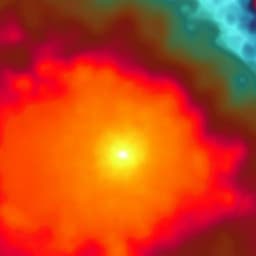
Earth Sciences
Amplified warming of North American cold extremes linked to human-induced changes in temperature variability
R. Blackport and J. C. Fyfe
This study by Russell Blackport and John C. Fyfe reveals that North America's winter cold extremes are warming at an alarming rate, outpacing the winter mean temperatures since 1980. The findings challenge earlier beliefs about cold extremes diminishing, highlighting a critical change in our climate dynamics.
~3 min • Beginner • English
Introduction
The study investigates how winter cold extremes over North America are changing in a warming climate and whether observed changes can be explained by shifts in mean temperature alone or also involve changes in variability (variance and higher moments such as skewness and kurtosis). Although theory, models, and observations increasingly indicate decreasing daily winter temperature variance over North America due to Arctic amplification (reduced meridional temperature gradient), recent notable cold-air outbreaks have led to claims that cold extremes may be becoming more frequent or persistent, possibly via Arctic-driven circulation changes. This has created disagreement between studies and uncertainty in projections. The authors aim to clarify these issues by analyzing the full shape of winter temperature distributions using quantile regression in observations and large-ensemble climate model simulations, applying pattern-based detection and attribution to assess human influence, and probing the role of Arctic sea-ice loss.
Literature Review
Prior work suggests that with global warming, cold extremes should decline in frequency and severity, while hot extremes increase. However, extremes also depend on changes in variability, not just mean shifts. Multiple studies and models indicate a robust decrease in sub-seasonal winter temperature variance over northern midlatitudes, particularly North America, largely due to Arctic amplification reducing the north–south temperature gradient. Observational studies have detected decreasing winter variance attributable to human influence. Models project increased skewness and decreased kurtosis of daily winter temperatures over midlatitudes, implying further relative reductions in cold extremes beyond variance changes, though emergence in observations had not been demonstrated. Countervailing literature posits that Arctic changes can induce circulation responses (e.g., altered jet stream or stratospheric polar vortex) increasing or sustaining cold extremes in North America, and raises concerns that models may not capture these linkages. This divergence between model- and observation-based interpretations has lowered confidence in projections of cold extremes.
Methodology
Data: Daily near-surface temperatures for winter (DJF) from ERA5 reanalysis (1979–2022) with additional checks using NCEP-DOE R-2 and JRA-55 reanalyses and Berkeley Earth gridded observations. The analysis focuses on North America, with regional averages over U.S. and southern Canada (30°–52°N, 140°–52°W, land only). Model simulations: Seven initial-condition large ensembles with historical forcing (ACCESS-ESM1-5, CanESM5, CESM2, EC-Earth3, GFDL-SPEAR-MED, MIROC6, MPI-ESM1-2-LR), totaling 300 members. Post-2014 uses SSP pathways (model-specific) but results are normalized. Single-forcing large ensembles for attribution available for three models (CanESM5, MIROC6—DAMIP GHG, AER, NAT; CESM2—GHG, AER, and an Everything Else experiment as a proxy for NAT). Sea-ice experiments: PAMIP atmosphere-only time-slice experiments (five models) comparing preindustrial vs present-day SST/SIC states to isolate effects of sea-ice loss and combined SST warming + SIC loss. Analysis: Quantile regression on daily DJF temperatures computes trends for percentiles 2nd to 98th at 2% intervals without removing the seasonal cycle to capture the absolute coldest days. Trends are expressed per °C of global annual mean warming by dividing local trends by the corresponding global mean trend (to account for model sensitivity and scenario differences). Variance and skewness are computed per winter to form 43-year time series; trends in the shape of distributions are decomposed into contributions from mean, variance, and higher moments using Legendre polynomial mapping of percentile trends (variance corresponds to the second Legendre polynomial). Zonal means are computed after gridpoint trends. For multi-model means, quantile and variability diagnostics are computed per member, then ensemble-mean per model, then averaged equally across models. Uncertainty: ERA5 trend uncertainty estimated via block bootstrap resampling by winter (1,000 resamples), with false discovery rate control (α=0.1) for gridpoint significance. Model–observation comparisons in per-°C units use an approach that rescales ensemble mean by each model’s global mean trend while preserving internal variability spread scaled by the observed global mean trend. Detection and attribution: Regression of observed trend patterns onto model “fingerprints” using one-signal (historical all-forcing) and three-signal (GHG, AER, NAT) analyses. Scaling factors and their uncertainties derived from internal variability samples constructed by removing ensemble means and adjusting magnitudes by √N/(N−1). Detectability assessed by whether scaling factors are significantly above zero; consistency assessed by overlap with one.
Key Findings
- Observations (ERA5, 1980–2022) show that coldest winter days (2nd percentile) over North America have warmed substantially faster than the winter mean. Over the United States and southern Canada (30°–52°N, land): the coldest days warmed about 2.2 times more than the winter mean and 3.2 times more than the global, annual mean trend.
- The warmest winter days (98th percentile) warmed more slowly than the mean over Canada, with weak, not statistically significant cooling in ERA5, opposite to the mean trend.
- The relative warming of cold extremes versus the mean extends farther south than the relative cooling of warm extremes, implying changes beyond variance in southern latitudes.
- Zonal analyses of percentile trends show an antisymmetric pattern north of ~45°N (cold days warming faster, warm days warming slower), consistent with decreased variance. South of ~45°N, only the very coldest days warm faster than the mean, indicating changes in higher moments.
- After removing mean and variance contributions, ERA5 shows strong positive trends for the coldest (<10th percentile) days and increased skewness south of ~45°N; models reproduce these features but with a narrower latitude band and somewhat weaker magnitude.
- Decomposition of 2nd-percentile trends: North of ~45°N, about half of the amplified warming is due to variance decreases; south of ~45°N, higher moments (e.g., skewness) drive most of the amplified warming, with little role for variance. Models show similar patterns though a larger fraction is explained by mean shifts.
- Detection and attribution: The spatial pattern of variance trends is highly detectable with a scaling factor ~1.7 (uncertainty overlaps 1), indicating models likely underestimate the magnitude but are consistent within variability. Mean trends are detectable by a small margin. Skewness is close to detectable (lower bound slightly below zero). Percentile-trend patterns are detectable even after removing mean and variance, demonstrating detectable changes in higher-moment-linked distributional shape. Single-forcing analyses attribute the detectable signals primarily to greenhouse gases.
- Sea-ice role (PAMIP): Experiments with SST warming + sea-ice loss reproduce enhanced warming of cold extremes and reduced warming of warm extremes north of ~40°N, plus higher-moment changes south of ~40–45°N. Sea-ice-loss-only experiments also yield stronger warming of the coldest days and variance reduction across latitudes, with midlatitude coldest days warming faster than the mean. The magnitude relative to the mean is weaker with sea-ice-only forcing, consistent with additional contributing processes and potential underestimation of Arctic response in prescribed-SIC designs.
Discussion
The findings demonstrate that winter cold extremes over North America have warmed more rapidly than can be explained by a uniform shift of the mean. North of ~45°N, the amplified warming of cold extremes is primarily due to decreased variance driven by Arctic amplification. South of ~45°N, where variance changes are small, amplified warming is linked to higher-moment changes (notably increased skewness), indicating transformations in the distribution’s shape that cannot be inferred from mean and variance alone. Large-ensemble climate models reproduce the observed spatial patterns and distributional changes, and pattern-based detection and attribution analyses show that these changes, including those associated with higher moments, are detectable and attributable to human influence, especially greenhouse gases. The sea-ice experiments support a mechanistic role for Arctic warming from sea-ice loss in both the variance reduction and the skewness increase that warms the coldest days disproportionately. These results counter claims that Arctic change is making North American cold extremes more common; instead, cold extremes are becoming less severe relative to both regional winter means and global warming, with observations often on the higher end of model-simulated warming for the coldest days but within the envelope of internal variability.
Conclusion
Cold extremes in North American winters since 1980 have warmed substantially faster than the winter mean and the global annual mean, due to both reduced variance (linked to Arctic amplification) and changes in higher moments such as skewness. These distributional changes are robust across reanalyses and climate models, are detectable in observations, and are attributable to human influence, with greenhouse gases as the primary driver. Experiments isolating sea-ice loss indicate that Arctic warming plays a central role in both variance reduction and higher-moment changes that selectively warm the coldest days. Practically, severe winter cold events will still occur due to inherently high winter variance and negative skewness over North America, but they will be less frequent and less intense in a warming climate. Future research should further clarify mechanisms behind higher-moment changes (e.g., roles of snow cover and meridional temperature gradient), refine regional attributions, evaluate model representation of Arctic–midlatitude linkages, and assess how these findings evolve under continued warming.
Limitations
Statistical significance at individual grid points is limited after multiple-testing control, although regional and pattern-scale signals are significant. Internal variability over the 43-year period is large and can influence observed magnitudes (e.g., ERA5 often near the high end for coldest-day warming; skewness detectability marginal). Detection and attribution assume models realistically represent internal variability. Prescribed sea-ice experiments may underestimate Arctic temperature responses, potentially weakening the simulated influence on variability and higher moments. Differences in SSP scenarios post-2014 are minimized by normalizing trends per °C of global warming, but residual scenario/forcing differences may remain.
Related Publications
Explore these studies to deepen your understanding of the subject.







